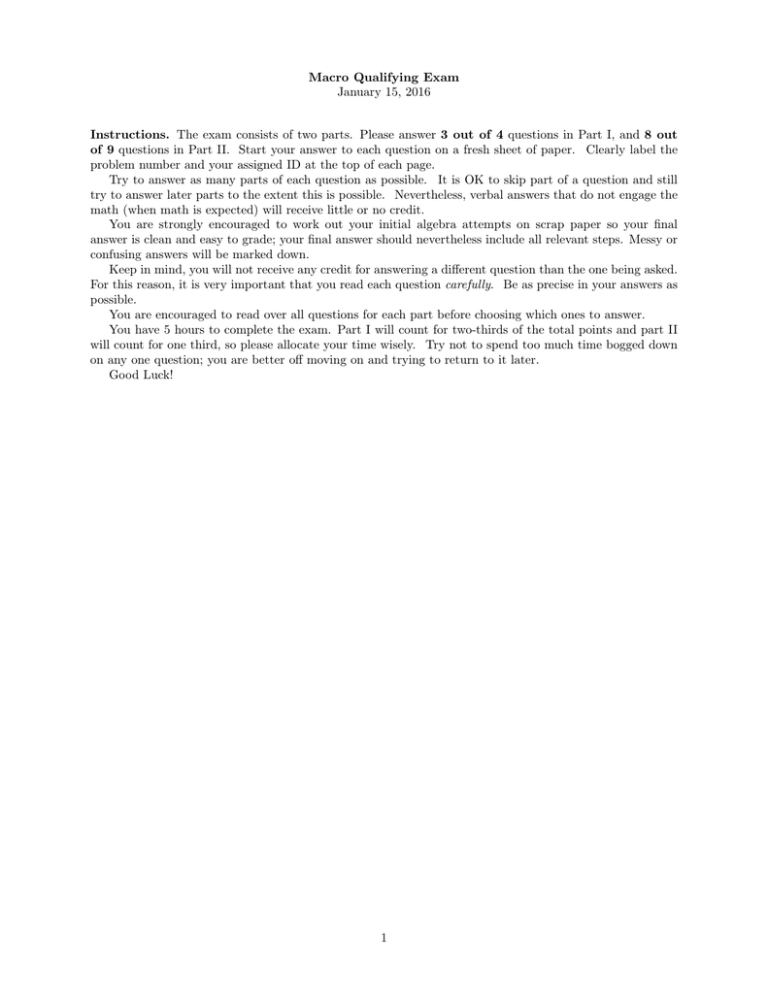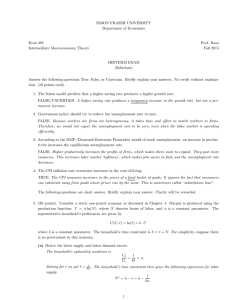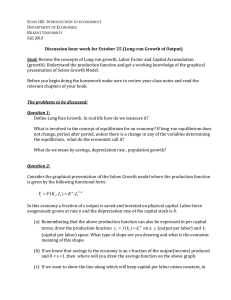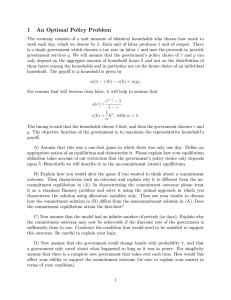Macro Qualifying Exam January 15, 2016
advertisement

Macro Qualifying Exam
January 15, 2016
Instructions. The exam consists of two parts. Please answer 3 out of 4 questions in Part I, and 8 out
of 9 questions in Part II. Start your answer to each question on a fresh sheet of paper. Clearly label the
problem number and your assigned ID at the top of each page.
Try to answer as many parts of each question as possible. It is OK to skip part of a question and still
try to answer later parts to the extent this is possible. Nevertheless, verbal answers that do not engage the
math (when math is expected) will receive little or no credit.
You are strongly encouraged to work out your initial algebra attempts on scrap paper so your final
answer is clean and easy to grade; your final answer should nevertheless include all relevant steps. Messy or
confusing answers will be marked down.
Keep in mind, you will not receive any credit for answering a different question than the one being asked.
For this reason, it is very important that you read each question carefully. Be as precise in your answers as
possible.
You are encouraged to read over all questions for each part before choosing which ones to answer.
You have 5 hours to complete the exam. Part I will count for two-thirds of the total points and part II
will count for one third, so please allocate your time wisely. Try not to spend too much time bogged down
on any one question; you are better off moving on and trying to return to it later.
Good Luck!
1
Part I: Modeling Exercises. Answer 3 out of 4 questions.
Exercise 1 Consider the following neoclassical growth model. A representative consumer cares about
∞
X
t=0
βt
c1−σ
t
1−σ
where β ∈ (0, 1) is the discount factor and σ > 0. A representative firm operates a Cobb Douglas production
function
Aktα n1−α
t
Denote the capital depreciation rate by δ > 0. The initial stock of capital is given, and nt ∈ [0, 1].
1. (15 points) Write down the social planning problem using dynamic programming.
2. (25 points) Find the functional Euler equation and transversality condition that solve this problem.
Give an expression for output, consumption and investment as a function of the policy function that
solves the planning problem.
3. (15 points) Assume that there is a government that taxes sales at a rate τt . The government uses
the tax revenue to finance government spending gt . The government budget constraint is balanced in
every period. Define a competitive equilibrium with taxes.
4. (20 points) Find the Euler equation and transversality condition that solves the competitive equilibrium
with taxes.
5. (25 points) For what value of τt does the solution to the competitive equilibrium coincide with the
solution to (1)? Explain.
2
Exercise 2 Consider an endowment economy with two infinitely-lived consumers indexed by i = 1, 2. Consumers have the following stream of endowments:
e1t = 2
in even periods and zero in odd periods and
e2t = 2
in odd periods and zero in even periods. Consumer i’s preferences over the consumption good are given by
U (c) =
∞
X
β t log(cit )
t=0
1. (20 points) Define an Arrow-Debreu equilibrium.
2. (30 points) Calculate an Arrow-Debreu equilibrium for this economy.
3. (25 points) Suppose that the planner weighs each consumer equally. Solve for the Pareto Optimal
allocation.
4. (25 points) Given that the planner weights each consumer equally, is the competitive equilibrium
Pareto Optimal? If so, explain. If not, find the Pareto weights for which the competitive equilibrium
is Pareto Optimal.
3
Exercise 3 Consider the following Neoclassical growth model in continuous time, where all lower-case variables are defined in per-capita terms. There is a representative household whose preferences over consumption
streams per capita c(t) at time t are defined by the following utility function:
1
u[c(t)] = − exp{−θc(t)}, θ > 0
θ
The representative household holds per-capita assets defined as units of capital stock, k(t). There is no
borrowing nor lending of capital. The representative household discounts future utility at constant rate
ρ > 0. Further, the representative household has one unit of labor, supplied inelastically at the going wage
w(t). Competitive firms produce a single good according to the production function y(t) = Ak(t)α , A >
0, α ∈ (0, 1). Capital stock is priced at r(t), and does not depreciate. The consumption good, capital good,
and debt are homogeneous, and therefore their common price is normalized to one at all times. Population
grows at a rate n > 0. There is no technological change.
Note: In the statement of the problems below, one would typically need to specify a transversality condition,
but you can simply write “TVC” and ignore the technical details associated with this part of the problem.
1. (5 points) Show that the absolute risk aversion coefficient −[u00 (c)/u0 (c)] of the utility function is
constant, while the relative risk aversion coefficient −c[u00 (c)/u0 (c)] is not. How does relative risk
aversion depend on current consumption?
2. (5 points) Show that, if at all times firms pay a wage w(t) equal to the marginal product of labor, and
if r(t) is equal to the marginal product of capital for all t, then the law of motion for capital stock will
be:
k̇(t) = Ak(t)α − c(t) − nk(t)
3. (10 points) Write down the optimal control problem for the representative household.
4. (15 points) Using the current–value Hamiltonian with costate variable µ(t), write the first-order necessary conditions for an optimal control, and find the Euler equation (EE) for consumption per capita.
5. (15 points) Write down the present–value Hamiltonian with costate variable λ(t), find the first-order
necessary conditions for an optimal control, and find the EE for consumption per capita.
6. (5 points) What is the relationship between µ(t) and λ(t)? Are the two EE’s different? Why or why
not?
7. (10 points) Write down the dynamical system describing the evolution of consumption per capita and
capital stock per capita at a competitive equilibrium. In so doing, think about what must be the wage
w(t) equal toIs ċ directly or inversely related with k? Why?
8. (10 points) Calculate the steady state css , kss for this model in terms of parameters only. How do
consumption and capital stock per capita vary with the discount rate? With the population growth
rate? With the risk aversion parameter θ? Provide intuition.
9. (25 points) Illustrate the dynamics of the steady of the model, including the steady state (css , kss ),
using a phase diagram with capital stock on the horizontal axis and consumption on the vertical axis.
What does the phase diagram suggest regarding the stability of the steady state?
4
Exercise 4 Consider the continuous-time Solow model where population, N grows at constant proportional
rate n and total factor productivity, A, grows at a constant proportional rate a. Let K denote the aggregate
stock of capital, and let
F (A, K, N ) = K α (AN )1−α
be the aggregate production function. The law of motion for aggregate capital is
K̇ = K α (AN )1−α − δK
K
. Derive a differential equation governing the behavior of k over time. Show
1. (20 points) Define k = AN
all relevant steps in your derivation.
2. (15 points) What happens to k in the long run? Justify your answer using a phase diagram.
3. (15 points) What happens to income per capita in the long run? Justify your answer.
4. (10 points) Define a Balanced Growth Path (BGP).
5. (30 points) To what extent does this economy converge to a BGP? Justify your answer fully. Thus,
for each component of the definition of a BGP, prove if the economic variables are consistent with that
restriction or not.
6. (10 points) What critique of the Solow model without technological change is overcome by this version
of the Solow model? In what sense is this critique overcome?
5
Part 2: Short Essay Questions. Answer 8 out of 9 questions.
Your answer to each question in part 2 should not exceed 15 lines, not including equations.
1. State the Kaldor’s growth facts. Explain how you may use them to calibrate a business cycle neoclassical
growth model.
2. In a recursive formulation of a competitive equilibrium, the aggregate stock of capital is a state variable
in the household’s maximization problem. Explain why.
3. State at least three business cycle facts for the US according to Cooley and Prescott’s article “Economic
Growth and Business Cycles”.
4. Explain why money, an intrinsically worthless asset, has positive value in an overlapping generations
model. Be specific. What assumptions do you need to make in order for money to have value?.
5. The Solow model with exogenous technological change and the neoclassical growth model with exogenous technological change both rationalize sustained economic growth consistent with the Kaldor facts.
State and briefly explain three reasons why moving from Solow growth to neoclassical growth can be
viewed as “progress” for economic science.
6. What features of the Dixit-Stiglitz model were most important for generating a tractable model of
monopolistic competition?
7. What research question is studied by Acemoglu, Johnson, and Robinson (2002)? Explain the identification problem they overcome. (In this case, the “identification problem” stems from the desire to
establish a causal link among variables of interest.)
8. Indicate three key differences between a Mankiw-Romer-Weil regression and a Barro regression.
9. What assumptions are needed to derive Solow’s growth accounting relationship?
6







